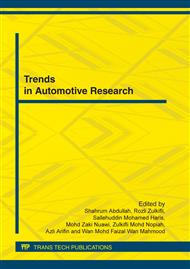p.1
p.6
p.12
p.16
p.21
p.26
p.31
p.38
p.43
Whole Body Vibrations Exposure to Malaysian Driver Using Novel IKaz Method
Abstract:
A car is a wheeled motor vehicle used for driving and transporting passengers. Therefore, cars are one of the most important forms of transportation worldwide. However, high magnitude of whole-body vibration (WBV) that can be associated with the car may lead to various diseases and health problems, such as low back pain, in humans. This study intended to present the value of Daily Exposure to Vibration A(8) and Vibration Dose Value (VDV) experienced by the car driver, with care taken to elucidate the effects of WBV on the human body. In addition, this study is done to implements a newly developed statistical analysis method called I-kaz 3D to determine the vibration level accordingly. The high value of I-kaz 3D coefficient corresponds to the high VDV value and otherwise. This study was conducted on a national car. The WBV exposure was measured for 10 min. Data was collected using an IEPE(ICPTM) accelerometer sensor connected to a DT9837 device, capable of effectively measuring and analyzing the vibration. The vibration results were displayed on a personal computer using a custom graphical user interface (GUI). From the results gathered, it is confirm that WBV absorbed by the human body increases with an increase in the duration and magnitude of vibration exposure by the driver, illustrated by the increase in the value of daily exposure to vibration A(8) and the calculated vibration dose value (VDV).
Info:
Periodical:
Pages:
21-25
Citation:
Online since:
April 2012
Price:
Сopyright:
© 2012 Trans Tech Publications Ltd. All Rights Reserved
Share:
Citation:


